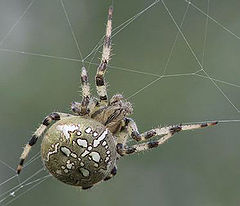Vierfleckkrossspider
| Vierfleckkrossspider | ||||||||||||
|---|---|---|---|---|---|---|---|---|---|---|---|---|

Vierfleckkspider ( Araneus quadratus ) (female) |
||||||||||||
| Systematics | ||||||||||||
|
||||||||||||
| Scientific name | ||||||||||||
| Araneus quadratus | ||||||||||||
| Clerck , 1757 |
The four-spot spider ( Araneus quadratus ) is a species of spider from the family of the real orb web spiders (Araneidae). The species is very variable in color and can be extremely colorful, but, in contrast to the more well-known garden spider, almost never stays in the middle of the web and is therefore noticed much less often. It occurs all over Europe and is considered safe.
description
Four-spot cross spiders are somewhat larger and stronger than garden cross spiders. The female can reach a body length of up to 18 millimeters; the male becomes 7-10 mm long. The front body ( prosoma ) is light beige-brown and shows a dark brown band on the back, which widens towards the front. The prosoma is hairy white-gray long.
The often almost spherical abdomen ( opisthosoma ) is enormously variable in color and can be from almost white to yellow, green-yellow, light or dark red to dark brown. It always shows a central band indicated by dots or band-shaped spots. There are two pair of white spots near the front edge of the back of the body, and two more white spots about twice as big follow in the middle. The four spots form the corner points of a trapezoid that widens towards the rear. The very strong legs are wide and dark ringed in all color variants.
distribution and habitat
The distribution of the four-spotted cross spider is limited to the Palearctic and ranges from Ireland to Europe and Central Asia to Kamchatka and Japan . The species occurs all over Europe.
The habitat of this spider is mainly moist tall herbaceous meadows, but also forest edges, clearings and dry grasslands. It occurs at heights of up to approx. 2,000 m. The cycle network is laid low (at a maximum height of 1 m). Above it, the female spider weaves itself out of leaves and grass in a hiding place that is open at the bottom, in which it sits very well camouflaged and is connected to the safety net via a signal thread. In contrast to the garden spider, the spider almost never stays in the middle of the web. Similar to the wasp spider , a large part of the prey consists of grasshoppers and similar grasshoppers . Adult animals occur from July to October.
Reproduction
The males' courtship and copulations are almost the same as in the garden spider, but the male courters less persistently and gives up more quickly with unwilling females. The female lays the egg cocoon in late summer to autumn. It is covered with yellow threads and attached to plants. Here, too, the eggs overwinter, but the young spiders hatch in the spring of the following year and develop into sexually mature spiders by autumn. So it is not a two-year cycle like the garden spider .
Danger
The species is widespread and common in suitable habitats. In Germany it is classified as "safe" in the Red List .
literature
- Heiko Bellmann: Cosmos Atlas Arachnids of Europe . 3rd edition, 2006. Kosmos, Stuttgart. ISBN 978-3-440-10746-1
- Ralph Platen, Bodo von Broen, Andreas Herrmann, Ulrich M. Ratschker & Peter Sacher: Total species list and red list of spiders, harvestmen and pseudoscorpions of the state of Brandenburg (Arachnida: Araneae, Opiliones, Pseudoscorpiones) with information on frequency and ecology. Nature conservation and landscape management in Brandenburg 8, booklet 2 (supplement); 1999.
Web links
Araneus quadratus in the World Spider Catalog


